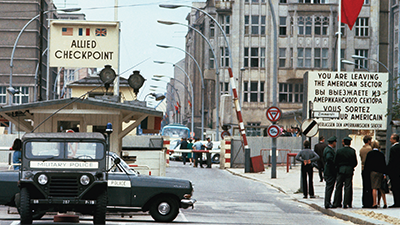The Cold War
Teacher Resources
Driving Question: What were the causes of the ideological struggle of the Cold War, and how did it impact global conflicts and alliances?
How did the Cold War start? At the end of World War II, the victorious allies lost both their shared enemy and their shared purpose. The two most powerful allied nations, United States and the Soviet Union, swiftly moved to consolidate their relative positions, resulting in the division of post-war Europe. The two nations soon became known as superpowers as they avoided direct conflict by involving themselves in the opposite sides of other countries’ conflicts, while also promoting their favored ideologies of capitalism or communism.
Learning Objectives
- Explain the causes and effects of the ideological struggle of the Cold War.
- Use the historical thinking practice of sourcing to assess different perspectives of who started the Cold War.
- Use the historical thinking practice of causation to categorize the multiple causes of the Cold War.
Vocab Terms:
- capitalism
- communism
- containment
- ideological
- non-alignment
- self-determination
- superpower
Opener: The Cold War
To teach this lesson step, refer to page 3 of the Lesson 8.2 Teaching Guide.
Curious about how other teachers approach the Cuban Missile Crisis simulation? Find additional resources and learn more by checking out the Community thread QOTW // How do you incorporate decolonization and the Cold War? // 04-15-2024.
Put your causation, contextualization, and claim testing skills to the test to solve a Cold War mystery.
Sourcing: Who Started the Cold War?
To teach this lesson step, refer to page 4 of the Lesson 8.2 Teaching Guide.
Need a way to give students feedback on their sourcing skills? Check out this Sourcing Feedback Form.
Want to know who started the Cold War? And does the answer to that question change depending on who’s making the claim? Compare two different sources to get to the root of this important question.
Cold War: An Overview
To teach this lesson step, refer to page 12 of the Lesson 8.2 Teaching Guide.
Trying to find additional Cold War resources? The Cold War topic page has all OER Project Cold War materials in one place!
Was the Cold War an economic crisis? A political crisis? Ideological struggle? Or was it all those things and more?
-
Guiding Questions
-
Before you read
Preview the questions below, and then skim the article. Be sure to look at the section headings and any images.
While you read
Look for answers to these questions:
- What was the basic difference at the heart of the Cold War conflict?
- What does this author identify as the three main features of the Cold War?
- Why did Stalin want to expand Soviet influence in Eastern Europe?
- What was the policy of containment and what does the author use as an example of this policy?
After you read
Respond to the following questions:
- To what extent does this article explain the causes and effects of the ideological struggle of the Cold War?
- The Cold War was a conflict that divided nations across the world. Which of the AP themes do you think best describes why the Cold War happened?
Causation: Cold War
To teach this lesson step, refer to page 13 of the Lesson 8.2 Teaching Guide.
Check out our Causation One-Pager for a quick review of this important historical thinking skill.
As you’ve seen throughout this lesson, the causes of the Cold War are varied and complex. Use your causation skills to evaluate the most important ones.
Closer: The Cold War
To teach this lesson step, refer to page 16 of the Lesson 8.2 Teaching Guide.
World War I, Russia, and Propaganda provided us a ton of resources for analyzing the past. Learn how other teachers guide students to analyze propaganda material in this Community thread.
The Cold War had many hot spots. In this activity, you’ll choose one Cold War event and write a breaking news story from a perspective of your choice.




